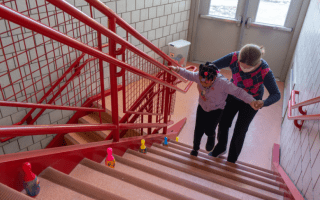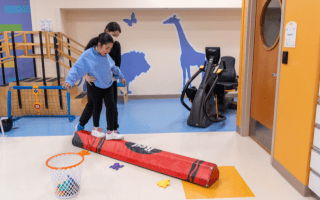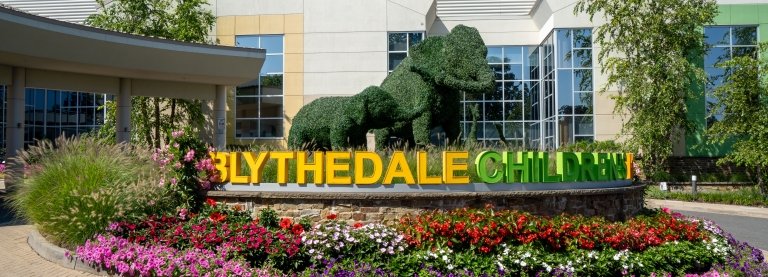Making Music Matter
Therapy Program Promotes Hope, Self-Expression & Socialization
“Every human being has an inherent musical ability. We all have a heartbeat and a heartbeat is a rhythm.”
It’s this sense of hope at Blythedale Children’s Hospital that has kept the beat going strong for the music therapy program.
But, what exactly is music therapy? It’s much more than playing an instrument or singing a song.
Music therapy is described as an evidence-based, goal-oriented healthcare profession in which music and musical elements are used within a therapeutic relationship by a credentialed professional to promote and maintain mental, physical and emotional health.
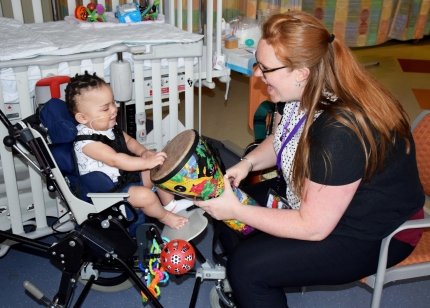
Three licensed music therapists at Blythedale share their talents with Hospital patients and residents at The Steven and Alexandra Cohen Pediatric Long Term Care Pavilion by providing beneficial individual and group sessions on a daily basis.
The benefits of this special program are also apparent through the increased level of support received by both kids and their families.
“Music Therapy is one of the most diverse therapeutic modalities we can offer,” said Kelsey Mayer, MS, CCLS, Director of Therapeutic and Developmental Support Services at Blythedale. “Having these credentialed health care professionals part of the patient healing process truly elevates the impact of our care delivery.”
The power of music comes alive for patients when strumming a guitar or banging a drum or humming a tune. And each modality is used as a tool to discover emotions, build bonds or initiate physical and mental healing.
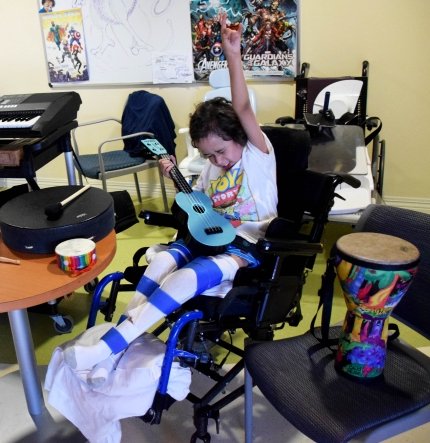
For Max, a patient on Blythedale’s Traumatic Brain Injury Unit, the daily regimen of intensive therapies and medical management of his diagnosis can sometimes be a bit overwhelming. But, with his music therapist by his side and a ukulele in his hand, the program has helped become an important outlet for his emotional and physical needs.
“He wants to create and has really big dreams and goals for himself, said Reissa Reiss, MA, LCAT, MT-BC, Max’s music therapist at Blythedale. “Music allows Max to be himself and try things he feels really good about, so that as he plays music, he can feel confident and that can translate to his other therapies.”
Another underlying goal for music therapists is to assist with intervention when patients are under distress. One such example is called entrainment where a music therapist takes cues from physical attributes of a patient, like breathing or heart rate, and creates music to match the tempo of the patient.
“By using this proven technique, I can meet the patient where they are at that moment and use my voice, an instrument or rhythm, to gradually reduce their escalating heart or pulse rate,” said Kat Penyak, MS, MT-BC, music therapist at Blythedale. “I try and put myself in their shoes, regardless if they are 10-years-old, 10-months-old or 10-weeks-old, because ultimately I just want to help the patient relax and let them know they are not alone.”
Many kids at Blythedale may also be experiencing varying degrees of cognitive and neurological deficits, but the joy of music therapy is that no musical background is required to achieve the therapeutic goals.
“Through the use of music therapy, the brain is almost able to rewire itself and work around the injury,” said Eva Simpson-Abrams, MS, MT-BC, music therapist for the long term care pavilion. “It leads to growth and it helps the brain heal.”
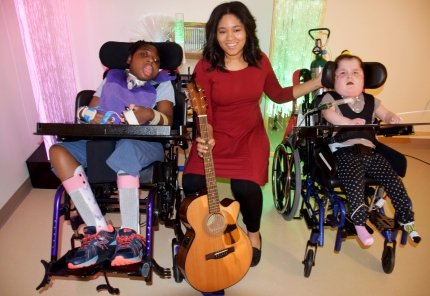
Jhanelle and Ashlyn, residents of The Steven and Alexandra Cohen Pediatric Long Term Care Pavilion, are unable to move independently or communicate their needs and wants due to their complex medical conditions. But, when they enter the unit’s new sensory room, their music therapist is able to enhance the special experience with soothing songs, chimes and shimmering strands of color-changing fiber optics. That’s when the smiles start appearing on each child’s face, they begin reaching for and trying to grasp the light strands and even take the occasional mid-session nap – signaling a truly restful and rewarding experience.
Music therapy allows residents in the long term care pavilion to express their feelings, increase fine and gross motor skills, and communicate in ways that utilize other parts of their bodies. Where words fail, music speaks.
“Here at Blythedale we use music therapy to address the patient’s abilities, rather than their disabilities,” said Kat Penyak. “We see what they are capable of and collectively help them reach their clinical and personal goals.”
